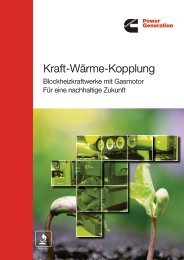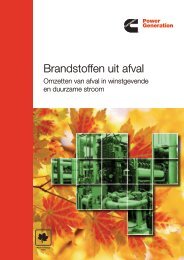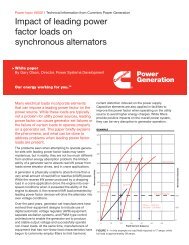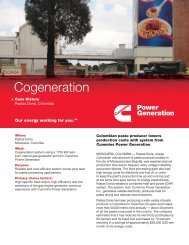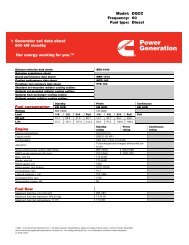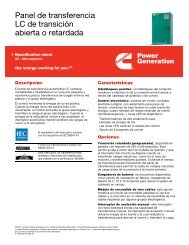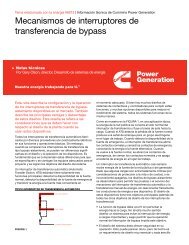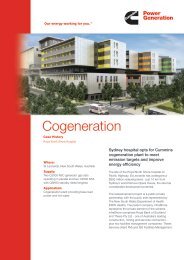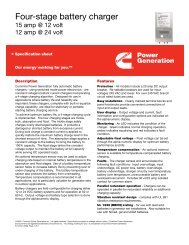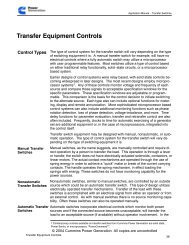appendix
appendix
appendix
Create successful ePaper yourself
Turn your PDF publications into a flip-book with our unique Google optimized e-Paper software.
Application Manual – Liquid Cooled Generator Sets<br />
• The surge kVA exceeds generator set capacity. The surge kVA requirement is similar<br />
to the surge kW requirement except that there is no derating for altitude or ambient<br />
temperature. GenSize uses the greater of cumulative kVA and Peak kVA (if any) to<br />
determine the load surge kVA requirement.<br />
• The alternator kW required exceeds the alternator capacity, which may be derated for<br />
altitude and ambient temperature by the project parameters. The altitude knee for<br />
alternators, however, is 1000m (3280 ft) and the temperature knee 40° C (104° F).<br />
Alternator kW will be derated 3% per 500m (1640 ft) of altitude above the knee and<br />
3% per 5° C (9° F) of ambient temperature over the knee.<br />
• The alternator kVA required exceeds alternator capacity, which can be derated by<br />
altitude and temperature in the same way as the alternator kW.<br />
• The total non–linear load requirement exceeds 25 percent of the total load requirement.<br />
This will exclude shunt–excited generators where PMG excitation is not available.<br />
The total non–linear load requirement is the sum of the Alternator kW values of<br />
all of the non–linear loads.<br />
• The calculated voltage and frequency dips exceed the limits set in the current project<br />
parameters.<br />
• Starting voltage dip is calculated using the higher of two values: dip based on the<br />
maximum Step kW or on the maximum step kVA.<br />
• Peak voltage dip is calculated only if loads in the project exhibit a running surge<br />
(cyclic loads or loads like medical imaging that have a high peak power requirement<br />
when they are operated.<br />
• Frequency dip is calculated using the higher of two values: maximum Step kW or<br />
Peak kW from loads which exhibit running surge.<br />
• The message, “No generator set is available that meets your running load requirements”<br />
usually means that something in the New Project Parameters has been<br />
changed after having specified the running load. For instance, you will get the message<br />
if you change from diesel to natural gas fuel or from no sound attenuation to<br />
Quite Site and the running load you had specified exceeds the capacity of the largest<br />
natural gas or Quite Site generator set available. It may also mean that your project<br />
falls into a “gap” in the Cummins Power Generation product line. At this point, lowering<br />
the minimum percent rated load in the project parameters could allow a recommended<br />
set. If this is the case, contact your local Cummins Power Generation distributor<br />
for help.<br />
• The message, “No generator set is available which meets your frequency or voltage<br />
dip requirements” generally means that the surge requirement of some load step is<br />
forcing selection of such a large generator set that the steady state running load falls<br />
below 30 percent of the generator set capacity. Since Cummins Power Generation<br />
does not recommend running at less than 30 percent of rated capacity, no set can be<br />
recommended. At this point, you may have several choices:<br />
• Increase the allowable voltage or frequency dip.<br />
• Reduce the minimum percent rated load to less than 30 percent.<br />
• Apply loads in more steps to lower the individual step surge load.<br />
• Provide reduced–voltage motor starting.<br />
• Parallel generator sets.<br />
• Add loads that do not have a high starting surge (lights, resistive loads, etc.).<br />
A–20 APPENDIX A<br />
Rev. Jan 2011



